NCERT Solutions for Class 9 Maths Chapter 11 Constructions
NCERT Solutions for Class 9 Maths Chapter 11 Constructions
NCERT solutions for class 9 maths chapter 11 Constructions are discusses in this article. These NCERT solutions are prepared by expert team at Careers360 considering the latest CBSE syllabus 2023-24. These solutions are designed in simple, easy to understand and comprehensive way to help students. The chapter construction class 9 deals with the construction of certain angles and also triangles in certain conditions.
When there is any construction project to start, then the first step to initiate that project is the planning and drawing. Geometrical constructions have their own line of study. If you want to pursue your career in this domain then the higher study related to this can be civil engineering and architecture. In this construction class 9 NCERT book chapter, there are 2 exercises having a total of 14 questions. Constructions Class 9 Questions And Answers have an in-depth solution to each and every question present in the practice exercises. For 360-degree help in your school examination preparation, you can use NCERT solutions for class 9 Maths.
Also read:
Constructions Class 9 Solutions - Important Points
Construction of Bisector of a Line Segment:
This construction task involves finding the midpoint of a given line segment. To construct the bisector, draw two congruent arcs from each endpoint of the segment. Where these arcs intersect is the midpoint of the line segment.
Construction of Bisector of a Given Angle:
Place the compass at the vertex of the angle.
Draw an arc that intersects both arms of the angle.
Repeat the process from the other arm of the angle.
The point where the two arcs intersect is the angle bisector.
Construction of an Equilateral Triangle:
Draw a line segment to represent one side of the equilateral triangle.
Place the compass at one endpoint of the line segment and draw an arc.
Repeat the process from the other endpoint.
Where the two arcs intersect, connect it to the endpoints of the line segment. This forms an equilateral triangle.
Construction of a Triangle Given Its Base, Sum of the Other Two Sides, and One Base Angle:
This construction involves constructing a triangle when you know one of its base angles, the length of the base, and the sum of the lengths of the other two sides. Specific construction steps would depend on the given measurements.
Construction of a Triangle Given Its Base, Difference of the Other Two Sides, and One Base Angle:
Similar to the previous construction, this involves constructing a triangle when you know one of its base angles, the length of the base, and the difference between the lengths of the other two sides. Specific construction steps would depend on the given measurements.
Construction of a Triangle of Given Perimeter and Two Base Angles:
This construction task involves constructing a triangle with specified base angles and a given perimeter. Specific construction steps would depend on the given measurements.
Free download NCERT Solutions for Class 9 Maths Chapter 11 Constructions for CBSE Exam.
Constructions Class 9 NCERT Solutions (Intext Questions and Exercise)
Class 9 maths chapter 11 question answer - Exercise: 11.1
Q1 Construct an angle of 90 o at the initial point of a given ray and justify the construction.
Answer:
The steps of construction to follow:
Step 1: Draw a ray OP.
Then, take O as the centre and any radius draw an arc cutting OP at Q.
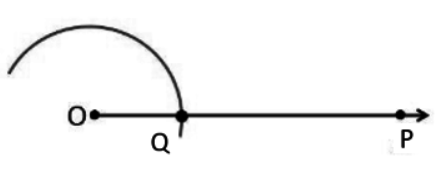
Step 2: Now, taking Q as the centre and with the same radius as before draw an arc cutting the previous arc at R. Repeat the process with R to cut the previous arc at S.
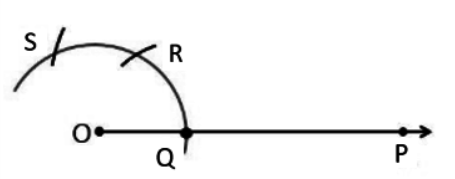
Step 3: Take R and S as centre draw the arc of radius more than the half of RS and draw two arcs intersecting at A. Then, join OA.
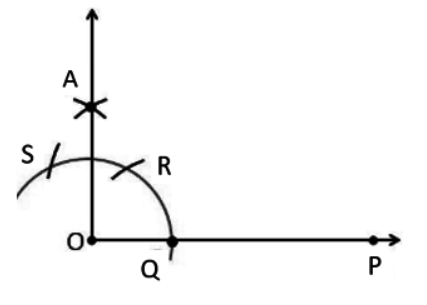
Hence, $\angle POA = 90^{\circ }$ .
Justification:
We need to justify, $\angle POA = 90^{\circ }$
So, join OR and OS and RQ. we obtain
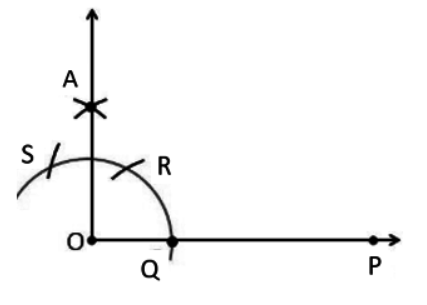
By construction OQ = OS = QR.
So, $\triangle ROQ$ is an equilateral triangle. Similarly $\triangle SOR$ is an equilateral triangle.
So, $\angle SOR = 60^{\circ}$
Now, $\angle ROQ = 60^{\circ}$ that means $\angle ROP = 60^{\circ}$ .
Then, join AS and AR:
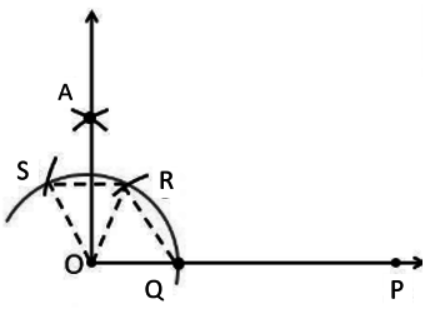
Now, in triangles OSA and ORA:
$SR = SR$ (common)
$AS = AR$ (Radii of same arcs)
$OS = OR$ (radii of the same arcs)
So, $\angle SOA = \angle ROA = \frac{1}{2}\angle SOR$
Therefore, $\angle ROA = 30^{\circ}$
and $\angle POA = \angle ROA+\angle POR = 30^{\circ} +60^{\circ} =90^{\circ}$
Hence, justified.
Q2 Construct an angle of 45 o at the initial point of a given ray and justify the construction.
Answer:
The steps of construction to follow:
Step 1: Draw a ray OY.
Then, take O as the centre and any radius, mark a point A on the arc ABC.

Step 2: Now, taking A as the centre and the same radius, mark a point B on the arc ABC.

Step 3: Take B as a centre and the same radius, mark a point C on the arc ABC.
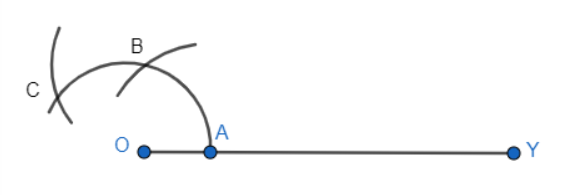
Step 4: Now, taking C and B as centre one by one, draw an arc from each centre intersecting each other at a point X.
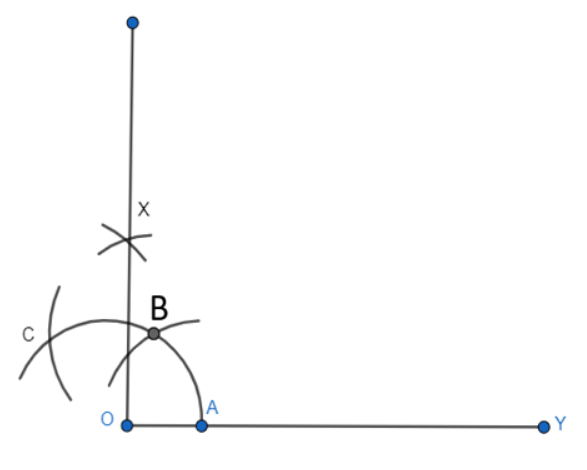
Step 5: X and O are joined and a ray making an angle $90^{\circ}$ with OY is formed.
Let the arc AC touches OX at E
Step 6: With A and E as centres, 2 arcs are marked intersecting each other at D and the bisector of angle XOY is drawn.
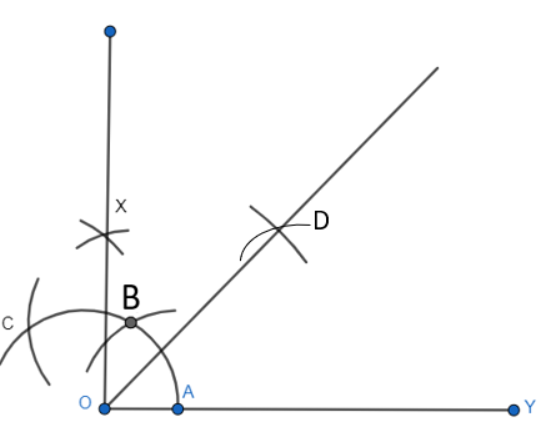
Justification:
By construction we have,
$\angle XOY = 90^{\circ}$
We constructed the bisector of $\angle XOY$ as $\angle DOY$
Thus,
$\angle DOY = \frac{1}{2}\angle XOY = \frac{1}{2}\times90^{\circ} = 45^{\circ}$
Q3 (i) Construct the angles of the following measurements: 30 o
Answer:
Steps to construction to follow:
Step 1: Draw a ray OY.

Step 2: Now, take A as a center and take any radius, then draw an arc AB cutting OY at A.

Step 3: Take A and B as centres, draw 2 arcs are marked intersecting each other at X and hence, the bisector of $30^{\circ}$ is constructed.
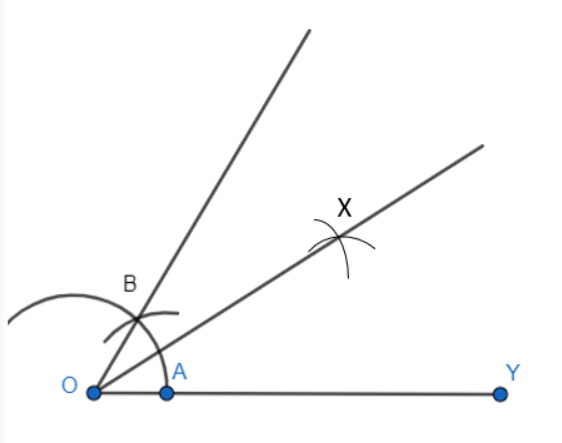
Thus, $\angle XOY$ is the required angle.
Q3.Construct the angles of the following measurements: (i) 30o
Edit Q
Q3 (ii) Construct the angles of the following measurements: $22\frac{1}{2}^\circ$
Answer:
Steps to construction to follow:
Step 1: Draw a ray OY.

Step 2: Now, take A as a centre and take any radius, then mark a point B on the arc

Step 3: Take B as a centre with the same radius, mark a point C on the arc ABC.
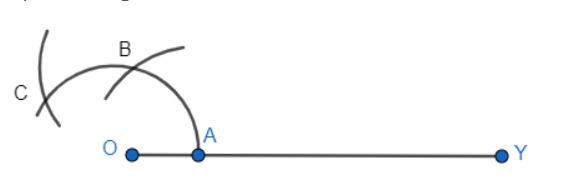
Step 4: Now, taking B and C as centres simultaneously, then draw an arc from each centre intersecting each other at a point X. Then join X and O and a ray making an angle with OY is formed.
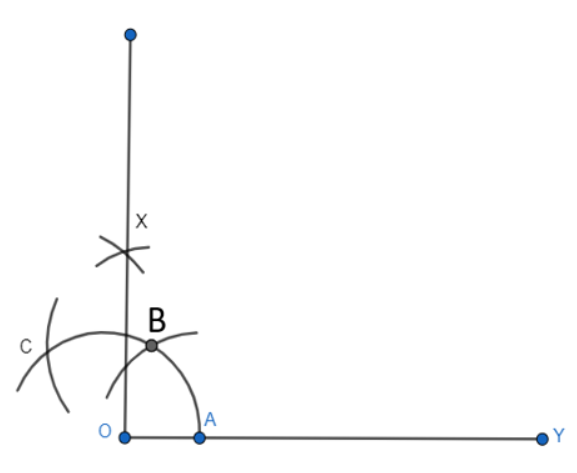
Let the arc AC touches OX at E
Step 5: Now, with A and E as centres, mark 2 arcs which intersect each other at D and we obtain the bisector of the angle $XOY$ .
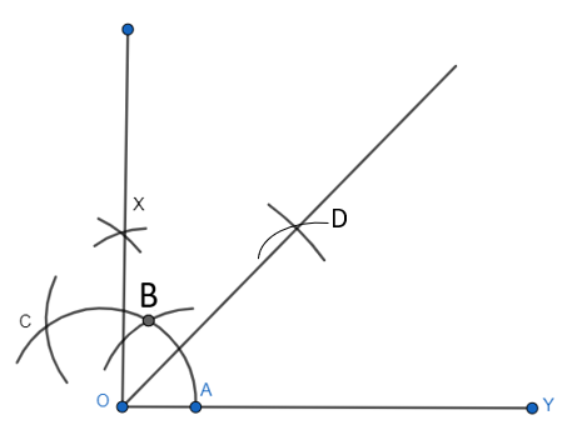
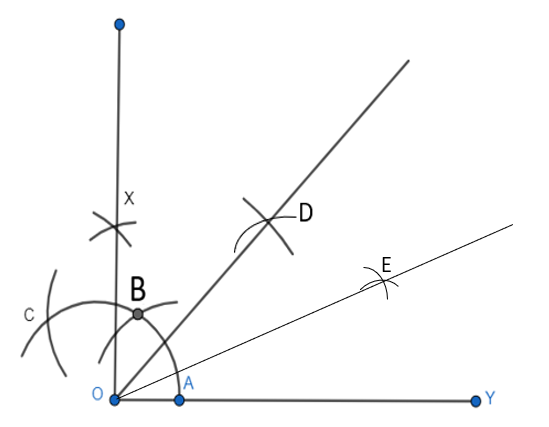
Q3 (iii) Construct the angles of the following measurements: 15 o
Answer:
Steps to construction to follow:
Step 1: Draw a ray OY.

Step 2: Now, take A as a centre and take any radius, draw an arc AB which cuts OY at A.

Step 3: Take A and B as a centre, then mark 2 arcs which intersect each other at X and Hence, the bisector is constructed of $30^{\circ}$ .
Step 4: Now, with A and E as centres, mark 2 arcs which intersect each other at D and we obtain the bisector of the angle $XOY$ .
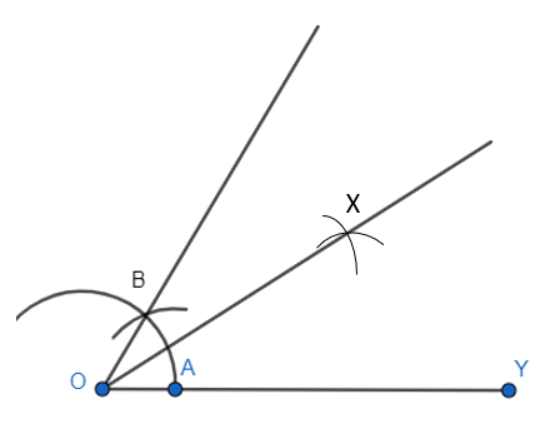
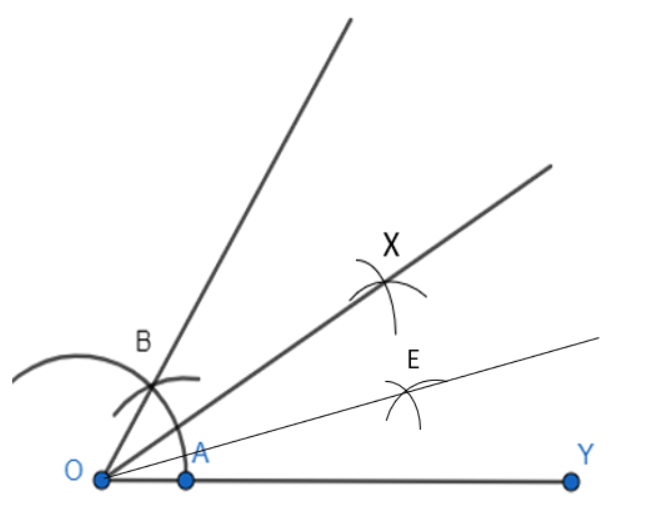
Thus, the angle of $15^{\circ}$ is obtained which is $\angle EOY.$
Q4 (i) Construct the following angles and verify by measuring them by a protractor: 75 o
Answer:
Steps to construction to follow:
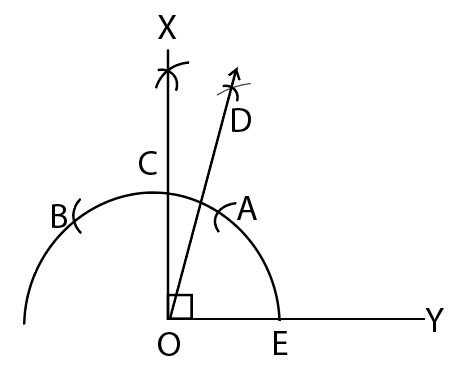
Step 1: Draw a ray OY.
Step 2: Now, taking O as the centre draw an arc ABC.
Step 3: On taking A as a centre, draw two arcs B and C on the arc ABC.
Step 4: Now, taking B and C as centres, arcs are made to intersect at point E and the $\angle EOY = 90^{\circ}$ is constructed.
Step 5: Taking A and C as centres, arcs are made to intersect at D.
Step 6: Now, join OD and hence, $\angle DOY = 75^{\circ}$ is constructed.
Hence, $\angle DOY$ is the required angle.
Q4 (ii) Construct the following angles and verify by measuring them by a protractor: 105 o
Answer:
The steps of construction to be followed:
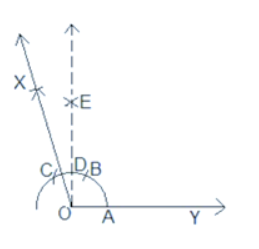
Step 1: Draw a ray OY.
Step 2: Then, taking O as a centre, draw an arc ABC.
Step 3: Now, with A as a centre, draw two arcs B and C which are made on the arc ABC.
Step 4: Taking B and C as centres simultaneously, arcs are made to intersect at E and $\angle EOY =90^{\circ}$ is constructed.
Step 5: With B and C as centres, arcs are made to intersect at X.
Step 6: Join the OX and we get $\angle XOY =105^{\circ}$ is constructed.
Thus, the angle $XOY$ is $105^{\circ}.$
Q4 (iii) Construct the following angles and verify by measuring them by a protractor: 135 o
Answer:
The steps of construction to be followed:
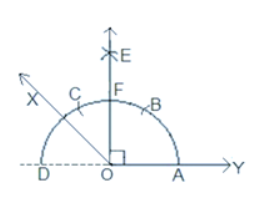
Step 1: Draw a ray DY.
Step 2: Draw an arc ACD with O as a center.
Step 3: Now, with A as a centre, draw two arcs B and C on the arc ACD.
Step 4: Taking B and C as centres, arcs are made to intersect at E and the angle formed is $\angle EOY = 90^{\circ}$ .
Step 5: Take F and D as centres, draw arcs to intersect at point X or the bisector of angle EOD is made.
Step 6: Join OX and the $\angle XOY = 135^{\circ}$ is made.
Hence, the angle required $\angle XOY$ is $135^{\circ}$ .
Q5 Construct an equilateral triangle, given its side and justify the construction.
Answer:
The following steps to make an equilateral triangle:
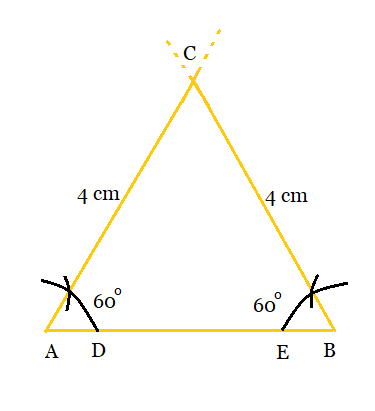
Step 1: Draw a line segment AB = 4 cm.

Step 2: With A and B as centres, make two arcs in the line segment AB. Mark it as D and E respectively.

Step 3: Now, with D and E as centres, make the two arcs cutting the previous arcs respectively, and forming an angle of $60^{\circ }$ each.
Step 4: Extend the lines of A and B until they intersect each other at point C.
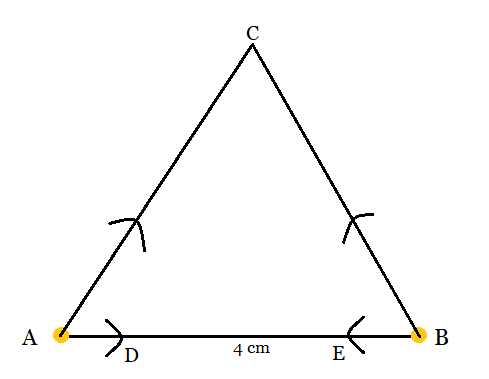
Hence, triangle constructed is ABC which is equilateral.
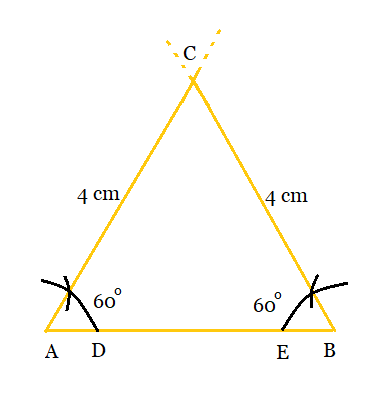
Now, Justification ;
Since the angles constructed are of $60^{\circ }$ each, so the third angle will also be $60^{\circ }$ .
$\left [ \because The\ sum\ of\ all\ angles\ of\ triangle = 180^{\circ} \right ]$
Class 9 maths chapter 11 NCERT solutions - Excercise: 11.2
Q1 Construct a triangle ABC in which $BC = 7cm$ , $\angle B = 75^\circ$ and $AB + AC = 13 cm$ .
Answer:
The steps of construction are as follows:
Step 1: Draw a line segment BC of 7cm length. Taking the help of protractor make an $\angle XBC = 75^{\circ}$ .
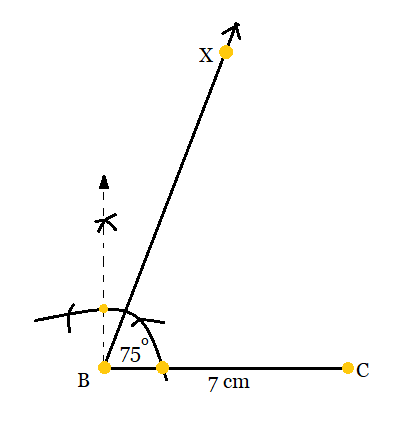
Step 2: Now, cut a line segment BD having 13 cm on BX which is $(AB+AC).$
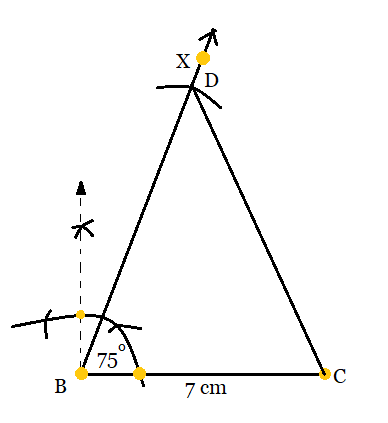
Step 3: Now, join CD.
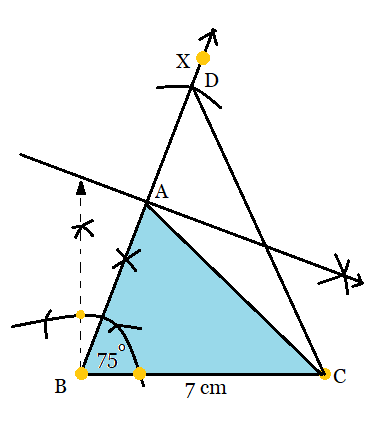
Step 4: Draw a perpendicular bisector of CD to intersect BD at a point A. Join AC. Then ABC is the required triangle
Hence, the required triangle is ABC.
Q2 Construct a triangle ABC in which $BC = 8cm$ , $\angle B = 45^\circ$ ° and $AB - AC = 3.5cm$
Answer:
The steps of construction to be followed:
Step 1: Draw a line segment BC = 8cm and make an angle of $45^{\circ}$ at point B i.e., $\angle XBC.$
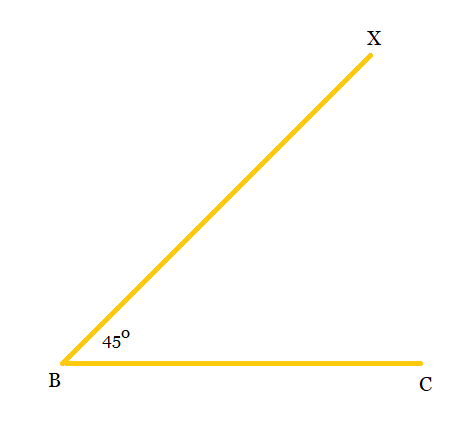
Step 2: Now, cut the line segment BD = 3.5 cm on ray BX. i.e. $(AB-AC)$ .
Step 3: Join CD and draw a perpendicular bisector of CD i.e., PQ.
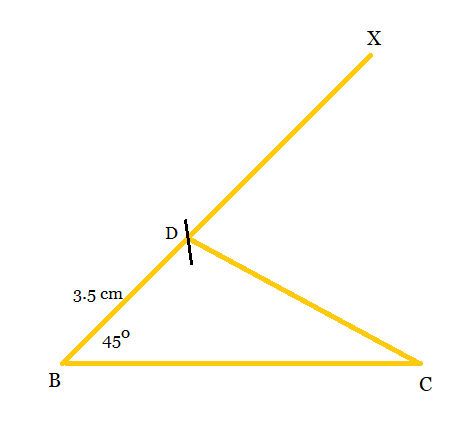
Step 4: Let the perpendicular bisector of CD intersects BX at point A. Then,
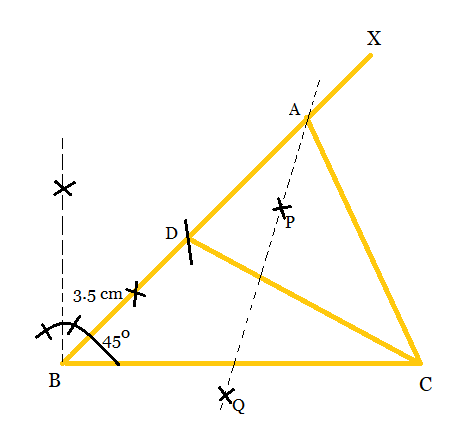
Step 5: Join AC, to get the required triangle $\triangle ABC.$
Q3 Construct a triangle PQR in which $QR = 6cm$ , $\angle Q = 60 ^\circ$ and $PR -PQ = 2cm$ .
Answer:
The steps of construction to be followed:
Step 1: Draw a ray QX and cut off a line segment QR which is equal to 6 cm in length.

Step 2: With an angle of $60^{\circ}$ with QR, construct a ray QY and extend it to form a line YQY'.
Step 3: Now, cut off a line segment QS equal to 2 cm from QY' and join RS.
Y
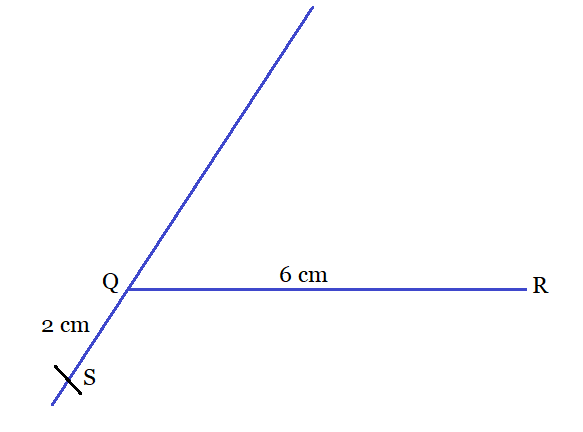
Y'
Step 4: Draw a perpendicular bisector of RS which intersects QY at a point P.
Step 5: Join PR to get the required triangle $\triangle PQR.$
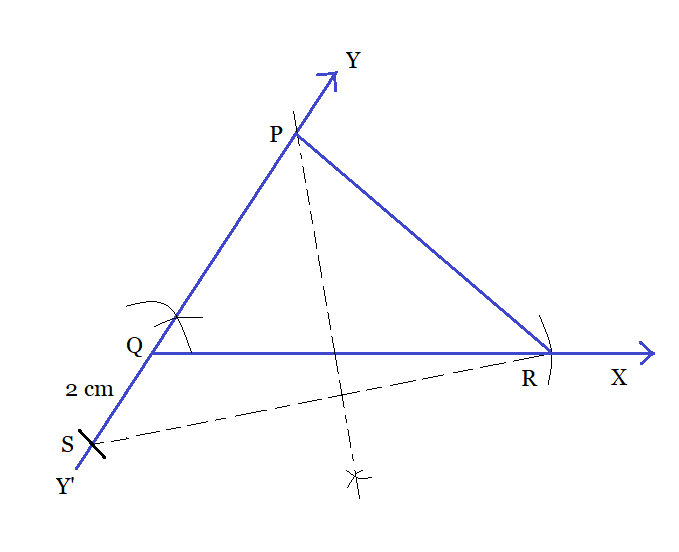
Answer:
The steps of construction to be followed:
Step 1: For given $XY+YZ+ZX = 11 cm$ , a line segment $PQ =11 cm$ is drawn.
Step 2: At points, P and Q angles of $\angle RPQ = 30^{\circ}$ and $\angle SQP =90^{\circ}$ are constructed respectively.
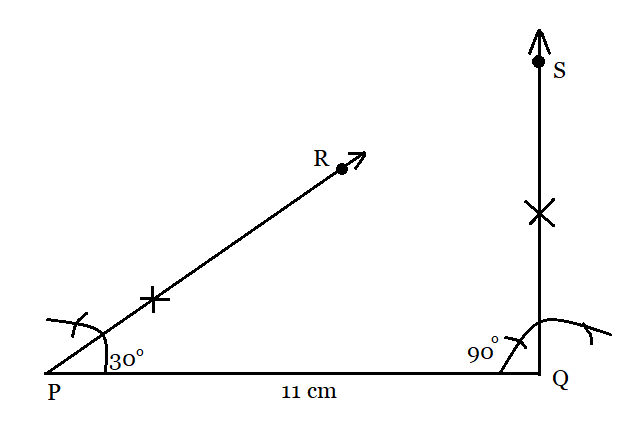
Step 3: Now, bisects the angle RPQ and SQP. The bisectors of these angles intersect each other at a point X.
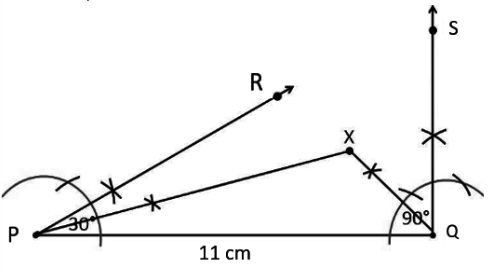
Step 4: Construct the perpendicular bisector of PX and QX, name them as TU and WV respectively.
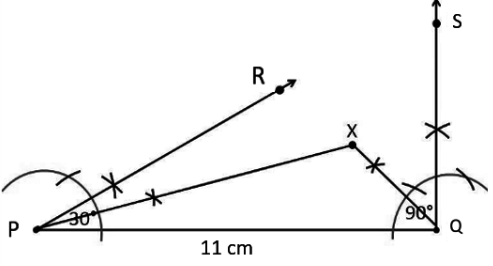
Step 5: Let the bisector TU intersect PQ at Y and bisector WV intersect PQ at Z. Then XY and ZY are joined.
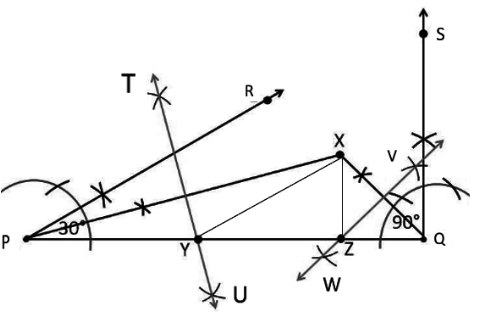
Therefore, $\triangle XYZ$ is the required triangle.
Q5 Construct a right triangle whose base is 12cm and sum of its hypotenuse and other side is 18 cm.
Answer:
The steps of construction to follow:
Step 1: Draw a ray BX and Cut off a line segment $BC=12cm$ from the ray.

Step 2: Now, construct an angle $\angle XBY = 90^{\circ}$ .
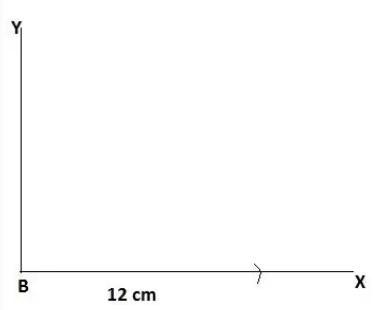
Step 3: Cut off a line segment BD of length 18 cm on BY. Then join the CD.
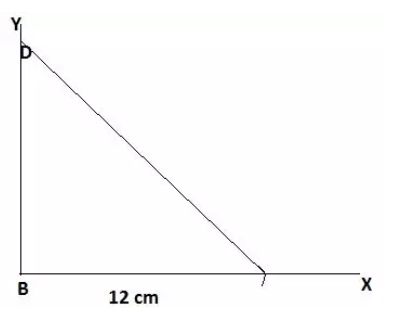
Step 4: Now, construct a perpendicular bisector of CD which intersects BD at A and AC is joined.
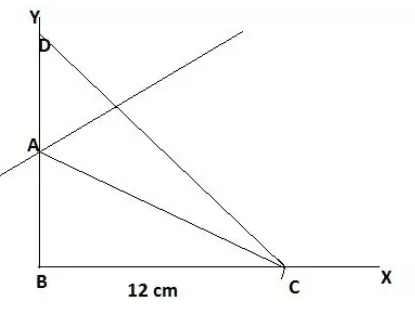
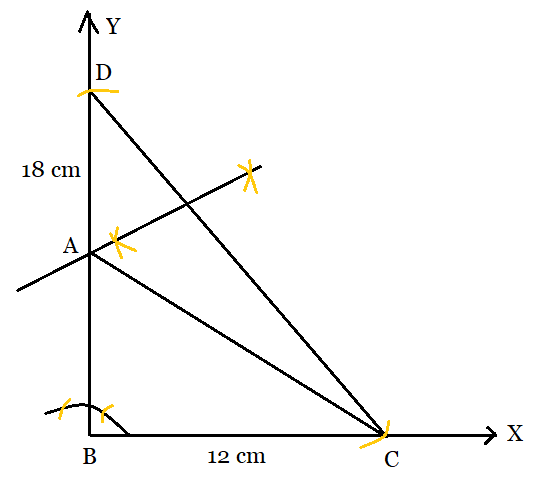
Thus, the constructed triangle is ABC.
Summary Of Class 9 Constructions NCERT Solutions
Constructions in geometry are the methods of drawing geometric shapes and figures using a straightedge and a compass.
Some basic constructions include drawing a line parallel to a given line through a given point, bisecting a given line segment, constructing the perpendicular bisector of a given line segment, and drawing an angle of a given measure.
To construct a perpendicular bisector of a given line segment AB, we draw a circle with A and B as its endpoints, then draw another circle with the same radius and center at B. The intersection of the two circles gives the midpoint M of AB. The line passing through M and perpendicular to AB is the perpendicular bisector of AB.
To construct an angle of a given measure, we first draw a ray with an endpoint O. We then place the compass at O and draw an arc intersecting the ray at point A. We then draw another arc with the same radius and center at A. We mark the point of intersection of these two arcs as B. The angle ∠AOB is the required angle.
Constructions are useful in various fields, such as architecture, engineering, and art.
The accuracy of constructions depends on the precision of the tools used and the skill of the person performing the construction.
The constructions discussed in this chapter are important in higher-level geometry, and they form the basis for several advanced constructions and theorems.
Here students can find class 9 maths ch 11 question answer using exercise link given below.
NCERT solutions for class 9 maths chapter wise
| Chapter No. | Chapter Name |
| Chapter 1 | Number Systems |
| Chapter 2 | Polynomials |
| Chapter 3 | Coordinate Geometry |
| Chapter 4 | Linear Equations In Two Variables |
| Chapter 5 | Introduction to Euclid's Geometry |
| Chapter 6 | Lines And Angles |
| Chapter 7 | Triangles |
| Chapter 8 | Quadrilaterals |
| Chapter 9 | Areas of Parallelograms and Triangles |
| Chapter 10 | Circles |
| Chapter 11 | Constructions |
| Chapter 12 | Heron’s Formula |
| Chapter 13 | Surface Area and Volumes |
| Chapter 14 | Statistics |
| Chapter 15 | Probability |
NCERT solutions for class 9 subject wise
How to use NCERT solutions for class 9 maths chapter 11 Constructions
- Understand the basic construction of angles using the previous class book.
- Learn the constructional process of triangles and rectangles.
- Go through some solved examples to understand the solutions pattern.
- Apply the concepts learned in the practice exercises.
- If you feel trouble in solving any problem then take the assistance of NCERT solutions for class 9 maths chapter 11 Constructions.
NCERT Books and NCERT Syllabus
Frequently Asked Questions (FAQs)
Basic Construction and Construction of triangles are two important topics in this chapter. Students can priorities the important chapters according to the NCERT syllabus and practice them to get good score well in the exam. practicing These NCERT Solutions will help students to command the concepts and provide confidence during the exam which ultimately lead to score well in the exams.
Here students can get NCERT solutions for class 9 . these solutions are prepared by expert team at Careers360 conidering the students demand and thus are very beneficial for students. After practicing these solutions and problems you will get in-depth understanding of the concepts.
NCERT Solutions for ch 11 maths class 9 are a valuable resource that offers comprehensive information and understanding of every concept, which enables students to solve all types of questions, regardless of their level of difficulty. Consistent practice is crucial to learning and scoring well in Mathematics. Therefore, a wide range of questions, along with their solutions, shortcut techniques, and detailed explanations, are provided to practice any concept thoroughly.
Courses After 12th
Applications for Admissions are open.
As per latest syllabus. Physics formulas, equations, & laws of class 11 & 12th chapters
JEE Main Important Chemistry formulas
Get nowAs per latest syllabus. Chemistry formulas, equations, & laws of class 11 & 12th chapters
JEE Main high scoring chapters and topics
Get nowAs per latest 2024 syllabus. Study 40% syllabus and score upto 100% marks in JEE
JEE Main Important Mathematics Formulas
Get nowAs per latest syllabus. Maths formulas, equations, & theorems of class 11 & 12th chapters
